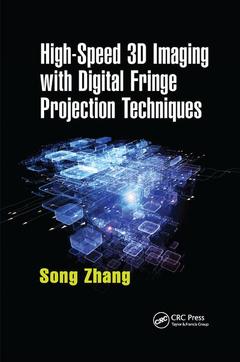High-Speed 3D Imaging with Digital Fringe Projection Techniques Optical Sciences and Applications of Light Series
Auteur : Zhang Song

Digital fringe projection (DFP) techniques are used for non-contact shape measurement of 3D images. In the rapidly expanding field of 3D high-speed imaging, the demand for DFP continues to grow due to the technology?s fast speed, flexibility, low cost, and high accuracy.
High-Speed 3D Imaging with Digital Fringe Projection Techniques discusses the generation of digital fringe with digital video projection devices, covering a variety of core technical aspects. The book begins by establishing the theoretical foundations of fringe pattern analysis, reviewing various 3D imaging techniques while highlighting the advantages of DFP. The author then:
- Describes the differences between digital light processing (DLP), liquid crystal display (LCD), and liquid crystal on silicon (LCoS)
- Explains how to unwrap phase maps temporally and spatially
- Shows how to generate fringe patterns with video projectors
- Demonstrates how to convert phase to coordinates through system calibrations
- Provides a detailed example of a built-from-scratch 3D imaging system
Incorporating valuable insights gained during the author?s 15+ years of 3D imaging research, High-Speed 3D Imaging with Digital Fringe Projection Techniques illuminates the pathway to advancement in high-speed 3D optical imaging using DFP.
Introduction. Theoretical Foundation of Fringe Analysis Techniques. Digital Fringe Generation Technique. Temporal Phase Unwrapping for Digital Fringe Projection Systems. Spatial Phase-Unwrapping Algorithm for Real-Time Applications. Projector Nonlinear Gamma Calibration and Correction. Digital Fringe Projection System Calibration. Hands-On Example of System Design and Development. Practical Considerations for System Development. Toward High-Speed 3D Imaging with Phase-Shifting Methods.
Song Zhang earned his BS from the University of Science and Technology of China, and his MS and PhD in mechanical engineering from Stony Brook University. He then spent three years in the Mathematics Department at Harvard University before joining Iowa State University as an assistant professor of mechanical engineering. He recently moved to Purdue University, where he is currently an associate professor of mechanical engineering. A widely published and highly decorated SPIE fellow, Professor Zhang is often credited with developing the first-ever high-resolution, real-time 3D optical imaging system. Besides being extensively utilized in academia, the technologies Professor Zhang has developed have been used by the rock band Radiohead to create a music video for the 2007 song "House of Cards," and by Zaftig Films to produce the 2015 movie Focus.
Date de parution : 12-2019
15.6x23.4 cm
Date de parution : 02-2016
15.6x23.4 cm
Thèmes de High-Speed 3D Imaging with Digital Fringe Projection... :
Mots-clés :
DLP Projector; Fringe Patterns; SLI; Phase Unwrapping Algorithm; Structured Light Illumination; Error Compensation Method; Spatial Phase Unwrapping; LCoS Projector; Temporal Phase Unwrapping; Phase Shifted Fringe Patterns; Fringe Projection System Calibration; Digital Fringe Projection; Fringe Projection Systems; Fringe Images; Fringe Analysis; Conjugate Components; Object Surface; LCoS; Phase Unwrapping; Liquid Crystal on Silicon; Nonlinear Gamma; LCD; Fringe Analysis Methods; Liquid Crystal Display; Sinusoidal Fringe Patterns; DLP; World Coordinate System; Digital Light Processing; Calibration Target; Fringe Projection; Structured Light System; Fringe Projection Techniques; Fringe Period; Digital Fringe Generation; Phase Map; DFP; Absolute Phase; Exposure Time; Digital Fringe Projection Techniques; Scan Line Algorithm; Imaging; Li Ne; High-Speed Imaging; Dichroic Prism; 3D Imaging; Fringe Order; High-Speed 3D Imaging



